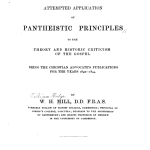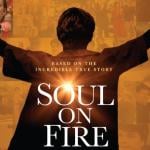I am happy to be participating in the blog tour for Craig Blomberg’s new book Can We Still Believe the Bible? (Brazos, 2014). I signed up to discuss the fifth chapter. Here is my response:
From creation to camels, the topic of the historical reliability of the Bible has been pretty hot news lately. So, it makes all the sense in the world for Craig Blomberg to address the question: “Aren’t Several Narrative Genres of the Bible Unhistorical?” (Chapter 5) in his new book Can We Still Believe the Bible? Sometimes Bible-reading skeptics find it too incredible that Jonah could be swallowed by a big fish and still live to tell the story. Or that the world was made in under a week. Or that Job had long conversations with his friends in poetic verse – for real? Do we have to believe these things happened historically?
Given that Blomberg wrote a book called The Historical Reliability of the Gospels, one might think that he pushes for defense of the direct historicity of the text on such matters. After all, many people make this into a clear either-or: either the text is “right” or “wrong” historically. Thankfully, Blomberg does not discuss this matter on these grounds. No, he turns the reader’s attention to genre and purpose. Not all narratives in Scripture are trying to make an objective and point-by-point historical claim. Blomberg gives the example of parables, texts like the Parable of the Good Samaritan, which are not narratives that are intended to be treated as historical fact. The parables make for an easy case – we can spot these and we know better than to see them as actual events. But what about other narratives: Gen 1-3, Jonah, Job, Matthew, Daniel, Revelation?
Here is what I think Blomberg does (which I find helpful). He notes that in cases like Job, genre matters are complex and it very well could be that “epic and legend are…built around historical characters.” As for Jonah, Blomberg alerts readers to the possibility that “Jonah is fundamentally a historical account that dramatizes, for didactic and hortatory purposes, events that actually happened to the prophet of the same name in 2 Kings 14:25.” (It is not crystal clear where Blomberg himself stands on these issues, but he finds such theories possible and, perhaps, attractive.)
How about the authorship of Isaiah? Blomberg agrees that there is evidence for and against a traditional view (of one author [Isaiah] versus three authors). However, in his mind, such authorship questions have little to do with the truth of the message of Isaiah or what he considers “biblical inerrancy.”
Strengths
Overall, I was very satisfied with Blomberg’s discussion of historicity and inerrancy. He kept the focus on genre, and left room for there to be appropriate discussion about what a given book/text is actually trying to claim about its relationship to history. For example, when it comes to Gen 1-3, he is quick to note that the theological emphases are central: “it is likely that when the ancient Israelites wrote their history in forms reminiscent of other cultures’ myths, it was done deliberately to subvert those myths and attribute to the God of Israel what other peoples claim was the purview of their own deities.” Looking at the big picture, Blomberg urges us to determine whether or not a narrative (historically) is central to “God’s history of salvation for humanity.” In the case of Gen 2-3, he does not think it can be purely fictional. But that does not preclude the possibility of theological shaping for teaching purposes.
Blomberg takes quite a bit of time to evaluate the case study of the ejection of Robert Gundry from the Evangelical Theological Society on the grounds that Gundry could not be an inerrantist and also consider Matthew “midrash.” Blomberg defends Gundry’s right to have remained a member of ETS on the grounds that “it was not the role of the society to censure a member or try to censor his publications if he had made a good case for how his views could be consistent with inerrancy” – Yes, yes, yes! Students, Christians, readers, listen to Blomberg on this!
I think Blomberg did two things brilliantly in this chapter from a pedagogical standpoint: (1) he demonstrated that not all things are crystal clear in Scripture, so there must be respectful ongoing debate and dialogue on matters where wise and well-researched evangelicals tend to see things differently; and (2) biblical interpretation requires gobs of humility. Blomberg shows these in spades!
Ongoing Questions
Why Bother with the Chicago Statement on Biblical Inerrancy? In this chapter, Blomberg makes appeal to the CSBI on more than one occasion. Personally, I find the CSBI convoluted. On the one hand, Blomberg notes that a clear emphasis in the CSBI falls on proper determination of genre and textual purpose (so article 13 of CSBI). However, just prior (article 12), the CSBI states that “We further deny that scientific hypotheses about earth history may properly be used to overturn the teaching of Scripture on creation and the flood.” So, the CSBI does not seem to be leaving open the possibility that Gen 1-3 is not offering direct historical accounts of origins. Does that mean that only analysis of genre could clarify the proper interpretation of Gen 1-3 and not developments in scientific theory and knowledge? The CSBI seems to be saying, let’s be open to discuss historicity and genre on everything except Gen 1-3.
Like the US Constitution, I think people like Blomberg see the CSBI as a document that offers some flexibility in its interpretation. My question is: why bother? You can still be an inerrantist and try to define it on broader terms: “Scripture is true and without error in all that God intends to teach.” On that definition, I am happily an inerrantist!
Second question: Could the evangelists have made any mistakes unknowingly? The burden of Blomberg’s argument is that we really need to know the author’s intentions before making a decision about a text’s historical claims. On that issue, we are in agreement. But he does not seem to address possibilities where the author may have simply been wrong. For example, what would Blomberg say about Mark 2:25-26 where Mark has Jesus make reference to Abiathar as high priest during the incident where David requests the bread of the Presence. However, according to 1 Sam 21, Ahimelech was high priest. Now, there are all kinds of “solutions” to this problem, but I want to know whether Blomberg could entertain the possibility of Mark simply making a mistake. (On this particular issue, I am undecided, so I have no dog in this fight.)
Third question – perhaps the most important one: What is Blomberg’s theory of inspiration such that biblical authors are able to tell the whole truth perfectly? Let’s say Blomberg believes that Luke’s gospel has a strong historical foundation in the reality of the life and ministry of Jesus. How is it possible that Luke gets this just right? Even if Luke did all his homework right and checked and double-checked all his facts, we know that incidental mistakes happen. How does inspiration work such that the gospel of Luke (for example) does not contain these normal kinds of errors? Again, I am not trying to interrogate Blomberg – I get asked this kind of thing from students all the time, and I just want to know how he answers such questions!
Final words
I will admit that, at first, I wondered whether this was your typical apologetics textbook where major questions that Bible readers ask are addressed at the surface level and challenges are swept under the carpet. Thankfully, this chapter put my mind at ease. Blomberg writes as one who fully recognizes the messiness of biblical interpretation and his reflections are mature, his case studies informative.











